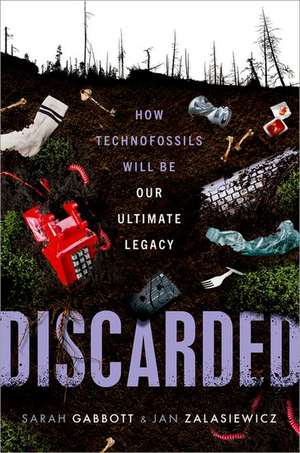Discarded: How Technofossils Will be Our Ultimate Legacy
Autor Sarah Gabbott, Jan Zalasiewiczen Limba Engleză Hardback – 13 feb 2025
Preț: 106.86 lei
Preț vechi: 127.22 lei
-16% Nou
Puncte Express: 160
Preț estimativ în valută:
20.45€ • 21.27$ • 16.88£
20.45€ • 21.27$ • 16.88£
Carte disponibilă
Livrare economică 12-18 martie
Livrare express 07-13 martie pentru 48.88 lei
Preluare comenzi: 021 569.72.76
Specificații
ISBN-13: 9780192869333
ISBN-10: 0192869337
Pagini: 256
Ilustrații: 25 black and white images
Dimensiuni: 163 x 241 x 24 mm
Greutate: 0.45 kg
Editura: OUP OXFORD
Colecția OUP Oxford
Locul publicării:Oxford, United Kingdom
ISBN-10: 0192869337
Pagini: 256
Ilustrații: 25 black and white images
Dimensiuni: 163 x 241 x 24 mm
Greutate: 0.45 kg
Editura: OUP OXFORD
Colecția OUP Oxford
Locul publicării:Oxford, United Kingdom
Notă biografică
Sarah Gabbott is a Professor of Palaeobiology at the University of Leicester. She researches the fossil record of ancient life and is particularly interested in understanding how fossils form and what they reveal about evolution and ecology. She actively seeks new fossil specimens from across the globe, going on digs to China, South Africa and the Canadian Rockies. She also works in the laboratory analyzing fossils and undertaking grisly experiments to determine how decomposition affects fossilization. Recently, she has turned her attention to the potential fossil record created by human activity, especially thinking about how long our 'artefacts' will endure.Jan Zalasiewicz is Emeritus Professor of Palaeobiology at the University of Leicester. He was formerly a field geologist and palaeontologist with the British Geological Survey, involved in the geological mapping of eastern England and central Wales. His interests include Early Palaeozoic fossils, notably the graptolites (a kind of extinct zooplankton), mud and mudrocks, the Quaternary Ice Ages, the nature of geological time, and the geology made by humans. In recent years he has helped develop the concept of an Anthropocene epoch. He has written many popular science articles and books.
